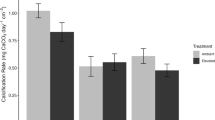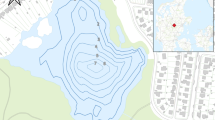Abstract
Aqueous calcium (Ca) concentrations are currently decreasing in many softwater lakes on the Boreal Shield. As the onset of these declines often pre-date direct monitoring programs, indirect techniques are required to examine the impacts of reduced Ca availability on aquatic communities with relatively high Ca demands such as the Cladocera (Class: Branchiopoda). Among the Cladocera, the family Daphniidae has been identified as a taxonomic group potentially useful for inferring past Ca concentrations due to their high Ca demands and preservation in lake sediments. Here, we use a “top/bottom” paleolimnological analysis to compare present-day cladoceran communities preserved in the surface sediments of 36 softwater lakes in south-central Ontario, Canada, which are potentially vulnerable to Ca decline (i.e. small headwater systems with present-day lakewater [Ca] < 3 mg L−1), with the communities present in lake sediments deposited prior to the onset of regional acid deposition. To distinguish the potential impacts of lake acidification from those of Ca availability (as Ca and pH trends are strongly correlated in this region), the study lakes were chosen to be evenly distributed about a present-day lakewater pH of 6 and Ca concentration of 1.5 mg L−1 (threshold values). Despite the importance of pH as an explanatory variable for the present-day assemblages, a comparison of the sedimentary remains from the two time periods indicate there have been large declines since pre-industrial times in the relative abundances of Ca-rich Daphnia spp. (particularly of the Daphnia longispina species complex), regardless of present-day pH, accompanied by increases in the Ca-poor species Holopedium glacialis. These observations suggest that recent declines in Ca concentration may have already fallen below baseline conditions, with marked implications for ecosystem function due to the differential responses among cladoceran taxa.





Similar content being viewed by others
References
Alstad NEW, Skardal L, Hessen DO (1999) The effect of calcium concentration on the calcification of Daphnia magna. Limnol Oceanogr 44:2011–2017
Ashforth D, Yan ND (2008) The interactive effects of calcium concentration and temperature on the survival and reproduction of Daphnia pulex at high and low food concentrations. Limnol Oceanogr 53:420–432
Blanchfield PJ, Paterson MJ, Shearer JA, Schindler DW (2009) Johnson and Vallentyne’s legacy: 40 years of aquatic research at the experimental lakes area. Can J Fish Aquat Sci 66:1831–1836
Cairns A (2010) Field assessments and evidence of impact of calcium decline on Daphnia (Crustacea, Anomopoda) in Canadian Shield lakes. M.Sc. Thesis. York University, Canada
Cairns A, Yan ND (2009) A review of laboratory and field evidence of the influence of low ambient calcium concentrations on daphniids, gammarids and crayfish. Environ Rev 17:67–79
Cairns A, Elliott M, Yan ND, Weisz E (2006) Operationalizing CAISN project 1.V, Technical Report No. 1: lake selection. Technical report prepared for the Canadian Aquatic Invasive Species Network. Dorset Environmental Science Centre, Dorset, Ontario
Charles DF, Binford MW, Furlong ET, Hites RA, Mitchell MJ, Norton SA, Oldfield F, Paterson MJ, Smol JP, Uutala AJ, White JR, Whitehead DR, Wise RJ (1990) Paleoecological investigation of recent lake acidification in the Adirondcak Mountains, NY. J Paleolimnol 3:195–241
Chen G, Dalton C, Taylor D (2010) Cladocera as indicators of trophic state in Irish lakes. J Paleolimnol 44:465–481
Clarke KR (1993) Non-parametric multivariate analyses of changes in community structure. Aust J Ecol 18:117–143
Clarke KR, Gorley RN (2006) PRIMER v6: user manual/tutorial. PRIMER-E, Plymouth
Clerk S, Hall R, Quinlan R, Smol JP (2000) Quantitative inferences of past hypolimnetic anoxia and nutrient levels from a Canadian Precambrian Shield lake. J Paleolimnol 23:319–336
Cogbill CV, Likens GE (1974) Acid precipitation in the northeastern United States. Water Resour Res 10:1133–1137
DeSellas AM, Paterson AM, Sweetman JN, Smol JP (2008) Cladocera assemblages from the surface sediments of south-central Ontario (Canada) lakes and their relationships to measured environmental variables. Hydrobiologia 600:105–119
DeSellas AM, Paterson AM, Sweetman JN, Smol JP (2011) Assessing the effects of multiple environmental stressors on zooplankton assemblages in Boreal Shield lakes since pre-industrial times. J Limnol 70:41–56
Faulkenham SE, Hall RI, Dillon PJ, Karst-Riddoch T (2003) Effects of drought-induced acidification on diatom communities in acid-sensitive Ontario lakes. Limnol Oceanogr 48:1662–1673
Frey DG (1986) Cladocera analysis. In: Berglund BE (ed) Handbook of holocene palaeoecology and palaeohydrology. Wiley, New York, pp 667–692
Glew JR (1988) A portable extruding device for close interval sectioning of unconsolidated core samples. J Paleolimnol 1:235–239
Glew JR (1989) A new trigger mechanism for sediment samplers. J Paleolimnol 2:241–243
Greenaway P (1985) Calcium balance and moulting in the Crustacea. Biol Rev 60:425–454
Hall RI, Smol JP (1996) Paleolimnological assessment of long-term water-quality changes in south-central Ontario lakes affected by cottage development and acidification. Can J Fish Aquat Sci 53:1–17
Havens KE, Yan ND, Keller W (1993) Lake acidification—effects on crustacean zooplankton populations. Environ Sci Technol 27:1621–1624
Hebert PDN (1995) The Daphnia of North America: an illustrated fauna—CD-ROM. Cyber Natural Software. University of Guelph
Hessen DO (1985) Filtering structures and particle size selection in coexisting Cladocera. Oecologia 66:368–372
Hessen DO, Faafeng BA, Andersen T (1995) Replacement of herbivore zooplankton species along gradients of ecosystem productivity and fish predation pressure. Can J Fish Aquat Sci 52:733–742
Holt CA, Yan ND, Somers KM (2003) pH 6 as the threshold to use in critical load modeling for zooplankton community change with acidification in lakes of south-central Ontario: accounting for morphometry and geography. Can J Fish Aquat Sci 60:151–158
Houle D, Ouimet R, Couture S, Gagnon C (2006) Base cation reservoirs in soil control the buffering capacity of lakes in forested catchments. Can J Fish Aquat Sci 63:471–474
Jeziorski A, Yan ND (2006) Species identity and aqueous calcium concentrations as determinants of calcium concentrations of freshwater crustacean zooplankton. Can J Fish Aquat Sci 63:1007–1013
Jeziorski A, Yan ND, Paterson AM, DeSellas AM, Turner MA, Jeffries DS, Keller B, Weeber RC, McNicol DK, Palmer ME, McIver K, Arseneau K, Ginn BK, Cumming BF, Smol JP (2008) The widespread threat of calcium decline in fresh waters. Science 322:1374–1377
Jeziorski A, Paterson AM, Smol JP (2012) Crustacean zooplankton sedimentary remains from calcium-poor lakes: complex responses to threshold concentrations. Aquat Sci 74:121–131
Kamenik C, Szeroczyńska K, Schmidt R (2007) Relationships among recent Alpine Cladocera remains and their environment: implications for climate-change studies. Hydrobiologia 594:33–46
Keller W, Dixit SS, Heneberry J (2001) Calcium declines in northeastern Ontario lakes. Can J Fish Aquat Sci 58:2011–2020
Korhola A, Rautio M (2001) Cladocera and other branchiopod crustaceans. In: Smol JP, Birks HJB, Last WM (eds) Tracking environmental change using lake sediments. Volume 4: Zoological indicators. Kluwer, Dordrecht, pp 4–41
Korosi JB, Jeziorski A, Smol JP (2011) Using morphological characters of subfossil daphniid postabdominal claws to improve taxonomic resolution within species complexes. Hydrobiologia 676:117–128
Korosi JB, Burke SM, Thienpont JR, Smol JP (2012) Anomalous rise in algal production linked to lakewater calcium decline through food web interactions. Proc R Soc B 279:1210–1217
Kurek J, Korosi JB, Jeziorski A, Smol JP (2010) Establishing reliable minimum count sizes for cladoceran subfossils sampled from lake sediments. J Paleolimnol 44:603–612
Likens GE, Driscoll CT, Buso DC (1996) Long-term effects of acid rain: response and recovery of a forest ecosystem. Science 272:244–246
Likens GE, Driscoll CT, Buso DC, Siccama TG, Johnson CE, Lovett GM, Fahey TJ, Reiners WA, Ryan DF, Martin CW, Bailey SW (1998) The biogeochemistry of calcium at Hubbard Brook. Biogeochemistry 41:89–173
Little JL, Hall RI, Quinlan R, Smol JP (2000) Past trophic status and hypolimnetic anoxia during eutrophication and remediation of Gravenhurst Bay, Ontario: comparison of diatoms, chironomids, and historical records. Can J Fish Aquat Sci 57:333–341
Malley DF, Chang PSS (1986) Increase in the abundance of cladocera at pH 5.1 in experimentally-acidified lake 223, experimental lakes area, Ontario. Water Air Soil Poll 30:629–638
Mills RB, Paterson AM, Blais JM, Lean DRS, Smol JP, Mierle G (2009) Factors influencing the achievement of steady state in mercury contamination among lakes and catchments of south-central Ontario. Can J Fish Aquat Sci 66:187–200
Molot LA, Dillon PJ (2008) Long-term trends in catchment export and lake concentrations of base cations in the Dorset study area, central Ontario. Can J Fish Aquat Sci 65:809–820
Neary BP, Dillon PJ, Munro JR, Clark BJ (1990) The acidification of Ontario lakes: an assessment of their sensitivity and current status with respect to biological damage. Ontario Ministry of the Environment, Dorset
Oksanen J, Blanchet FG, Kindt R, Legendre P, O’Hara RB, Simpson GL, Solymos P, Stevens MHH, Wagner H (2010) Vegan: community ecology package. R package version 1.17-4. http://CRAN.R-project.org/package=vegan
Paterson MJ (1994) Paleolimnological reconstruction of recent changes in assemblages of Cladocera from acidified lakes in the Adirondack Mountains (New York). J Paleolimnol 11:189–200
R Development Core Team (2010) R: a language and environment for statistical computing. R Foundation for Statistical Computing, Vienna, Austria. ISBN 3-900051-07-0, URL http://www.R-project.org/
Shapiera M, Jeziorski A, Yan ND, Smol JP (2011) Calcium content of littoral Cladocera in three softwater lakes of the Canadian Shield. Hydrobiologia 678:77–83
Shapiera M, Jeziorski A, Paterson AM, Smol JP (2012) Cladoceran response to calcium decline and the subsequent inadvertent liming of a softwater Canadian lake. Water Air Soil Poll. doi:10.1007/s11270-011-1035-y
Shaw DM, Reilly GA, Muysson JR, Pattenden GE, Campbell FE (1967) An estimate of the chemical composition of the Canadian Precambrian Shield. Can J Earth Sci 4:829–853
Smirnov NN (1974) Fauna of the U.S.S.R., Crustacea. Vol 1: Chydoridae. Israel Program for Scientific Translations, Jerusalem
Smirnov NN (1996) Cladocera: the Chydorinae and Sayciinae (Chydoridae) of the world. SPB Academic Publishing, Amsterdam
Smol JP (2008) Pollution of lakes and rivers: a paleoenvironmental perspective, 2nd edn. Blackwell, Oxford
St. Louis VL, Breebaart L (1991) Calcium supplements in the diet of nestling tree swallows near acid sensitive lakes. The Condor 93:286–294
Stoddard JL, Jeffries DS, Lukewille A, Clair TA, Dillon PJ, Driscoll CT, Forsius M, Johnannessen M, Kahl JS, Kellogg JH, Kemp A, Mannio J, Monteith DT, Murdoch PS, Patrick S, Rebsdorf A, Skjelkvåle BL, Stainton MP, Traaen T, van Dam H, Webster KE, Wieting J, Wilander A (1999) Regional trends in aquatic recovery from acidification in North America and Europe. Nature 401:575–578
Sweetman JN, Smol JP (2006) A guide to the identification of cladoceran remains (Crustacea, Branchipoda) in Alaskan lake sediments. Arch Hydrobiol Suppl 151:353–394
Szeroczyńska K, Sarmaja-Korjonen K (2007) Atlas of subfossil Cladocera from central and northern Europe. Friends of the Lower Vistula Society, Świecie
Tan Q, Wang W (2009) The regulation of calcium in Daphnia magna reared in different calcium environments. Limnol Oceanogr 54:746–756
Tan Q, Wang W (2010) Interspecies differences in calcium content and requirement in four freshwater cladocerans explained by biokinetic parameters. Limnol Oceanogr 55:1426–1434
Wærvågen SB, Rukke NA, Hessen DO (2002) Calcium content of crustacean zooplankton and its potential role in species distribution. Freshw Biol 47:1866–1878
Watmough SA, Aherne J (2008) Estimating calcium weathering rates and future lake calcium concentrations in the Muskoka-Haliburton region of Ontario. Can J Fish Aquat Sci 65:821–833
Yan ND, Paterson AM, Somers KM, Scheider WA (2008a) An introduction to the Dorset special issue: transforming understanding of factors that regulate aquatic ecosystems on the southern Canadian Shield. Can J Fish Aquat Sci 65:781–785
Yan ND, Somers KM, Girard RE, Paterson AM, Keller B, Ramcharan CW, Rusak JA, Ingram R, Morgan GE, Gunn J (2008b) Long-term trends in zooplankton of Dorset, Ontario lakes: the probable interactive effects of changes in pH, TP, DOC and predators. Can J Fish Aquat Sci 65:862–877
Acknowledgments
This project was funded through a Natural Sciences and Engineering Research Council grant to JP Smol as well as through the Ontario Ministry of the Environment’s Best in Science Program.
Author information
Authors and Affiliations
Corresponding author
Rights and permissions
About this article
Cite this article
Jeziorski, A., Paterson, A.M. & Smol, J.P. Changes since the onset of acid deposition among calcium-sensitive cladoceran taxa within softwater lakes of Ontario, Canada. J Paleolimnol 48, 323–337 (2012). https://doi.org/10.1007/s10933-012-9600-y
Received:
Accepted:
Published:
Issue Date:
DOI: https://doi.org/10.1007/s10933-012-9600-y




